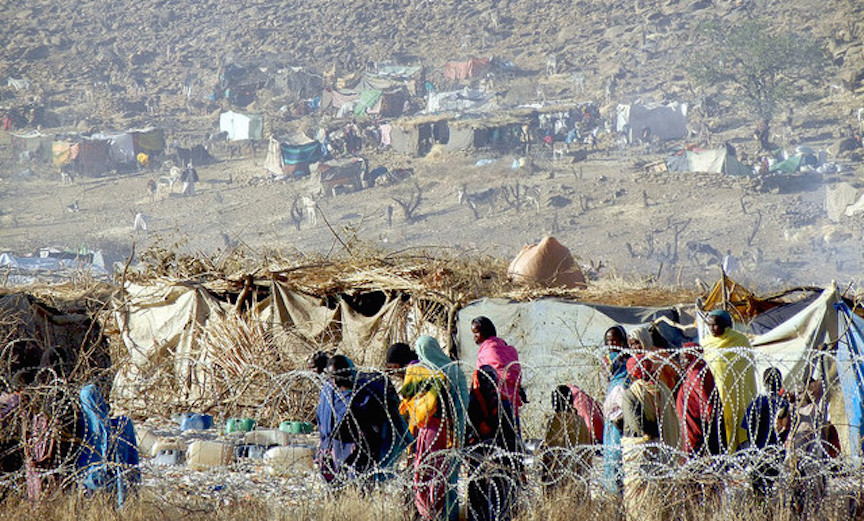from Darfur, the Most “Successful” Genocide in a Century—and “on our watch”
Eric Reeves | April 17, 2017 | http://wp.me/s45rOG-7849
APPENDIX A: Has the Dismantling of Darfur’s IDP Camps Begun?
As far back as the summer of 2004 plans were being considered, and mendacious public announcements by senior NIF/NCP officials spoke of returns as in full swing—a crude effort at making something so by declaring it so. Abdel Rahim Mohamed Hussein, then Minister of the Interior and the regime’s special representative on Darfur, announced on Sudanese government-controlled radio on July 9, 2004 “that 86 percent of the Internally Displaced Persons had already returned to their villages” (UN Integrated Regional Information Networks, July 12, 2004). Hussein further declared that “it was ‘most important’ to get people to return to their villages. Each state—the Darfur region has three—had its own plan of return.”
At the time camps for displaced persons in Darfur held more than 1 million people—leaving aside the large number of refugees (today this a population of approximately 300,000 according to the UN High Commission for Refugees). Presently, the UN Office for the Coordination of Humanitarian Affairs, which has frequently been either unreliable or badly out of date with its figures for internally displaced persons (IDPs), provides data indicating that the number if IDPs in all setting is approximately 2.7 million (see | http://sudanreeves.org/2017/03/19/internally-displaced-persons-in-darfur-the-invisible-catastrophe/).
Here it seems appropriate to recall that Hussein, the man speaking so callously of Darfuri IDPs, has been indicted by the International Criminal Court for massive crimes against humanity in Darfur. But there have been many such statements subsequently; indeed, sixteen months ago Vice-President Hassabo Mohamed Abdelrahman was reported by Sudan Tribune as making clear the regime’s view of the IDP camps:
In a speech delivered before the representatives of former rebel groups and IDPs in El-Fasher, North Darfur on Monday, [Second Vice-President Hassabo Mohamed Abdelrahman] said Darfur has “completely recovered from the war and is now looking forward to achieve a full peace, stability and development.”
“IDP camps represent a significant and unfortunate loss of dignity and rights of citizens in their country” he said and called on the displaced “to choose within no more than a month between resettlement or return to their original areas.”
He further reiterated his government’s commitment to take all the measures and do the needful to achieve this goal, stressing that “the year 2016 will see the end of displacement in Darfur.” Abdel Rahman told the meeting that he has just ended a visit to Karnoi and Tina areas in North Darfur, adding the two areas which were affected by the conflict have totally recovered. He said his visit with a big delegation to the two areas “is a message sceptics in the fact that security and stability are back in Darfur”… (Sudan Tribune, December 28, 2015 | El Fasher, North Darfur)
Dismantling IDP camps will not be a physical challenge for Khartoum’s génocidaires; the vast majority of these people will have no place to go
Khartoum regime Vice President Hassabo
Hassabo’s statement came a matter of days before Khartoum would launch the massive military offensive against the Jebel Marra massif in the center of Darfur. As many as 200,000 people were newly displaced in that campaign, perhaps more—humanitarian access has not been sufficient to allow for a full census. The claim by Hassabo that “security and stability are back in Darfur”—on the very eve of the Jebel Marra offensive, during which chemical weapons were used against civilians—is mendacity entirely in character for the regime.
In February 2017 Radio Dabanga reported on an explicit threat of camp dismantling:
14,000 displaced given days to vacate South Darfur camp | February 17, 2017 | KALMA CAMP
The Commissioner of Nyala locality in South Darfur has given the 14,000 residents of Centre 4 of Otash camp near the state capital less than a week to vacate it before it is dismantled. The spokesman for the Association of Displaced Persons and Refugees, Hussein Abusharati, told Radio Dabanga that a Land Cruiser mounted with a Dushka machine gun drove into the camp on Thursday afternoon. “It moved through the camp using a loudspeaker, calling on the displaced to evacuate the camp by February 22, without specifying an alternative place for the displaced to live.
The association denounced the Commissioner’s decision and held Government responsible for the implementation of the decision. It renewed its refusal to dismantle the camp, and conditioned the return of displaced persons to their home by provision of security and stability in their villages.
Abusharati warned of “dire consequences should the decision be implemented by force.” He called on state government “to cancel the decision so as to preserve the lives and property of the displaced.” He urged the residents of Centre 4 to approach UNAMID should the commissioner order the camp to be forcibly evacuated. He called on UNAMID, the international community, and human rights organisations to protect the displaced of camp Otash “so that there will not be a repeat of the massacre that occurred at Kalma camp in 2008.”
Abusharati was referring to an infamous incident in August 2008 when police attempted to enter Kalma campo by force, leaving 32 displaced people dead (see | “Now Sudan Is Attacking Refugee Camps,” The Wall Street Journal, 6 September 2008 | http://online.wsj.com/article/SB122065894281205691.html?mod=googlenews_wsj/). There has been no follow-up report from Radio Dabanga on the fate of Otash camp center 4; nor has there been a response from the feckless UNAMID or, more consequentially, the Western actors of consequence so eager to accelerate the process of rapprochement with Khartoum.
Silence on the part of the Trump administration is particularly significant, given the terms laid down for a lifting of sanctions on Khartoum when the Obama administration perversely decided on this action in its last week in office. “Humanitarian access” was to have been the key terms of any assessment of Khartoum’s behavior, both in the six months prior to the decision and the six months following.
What is all too clear is that if the IDP camps are emptied and dismantled, “humanitarian access” in any meaningful sense will have been almost entirely eroded. The concentrations of large populations in these camps are all that make the distribution of food and medicine possible, as well as the provision of clean water, shelter, and a modicum of security. If people are forced from the camps with no place to go, they will either perish or be forced to seek refuge in other camps—camps that may themselves be in the dismantling cross-hairs. Khartoum is of course aware of this, but relentlessly seeks to end the rationale for an international humanitarian presence in Darfur—and emptying the camps is the most efficient way of doing so.
Camp emptying and dismantling will also give Khartoum an argument for the withdrawal of the impotent but (for Khartoum) noisome presence of the UN/African Union “Hybrid” Mission for Darfur (UNAMID). Khartoum will be pushing hard for a large if not complete withdrawal of UNAMID from Darfur when the Mission comes up for UN Security Council reauthorization in two months. The force has already been cut severely from its originally mandated size, but because it has proved so ineffective while being terribly costly, there is diminishing support for a continuation of UNAMID. There seems to be almost no enthusiasm for the kind of meaningful civilian protection argued for in compelling terms recently by Jonathan Loeb, primary researcher and author for the last three significant human rights reports on Darfur (see “Time to Get Serious about Civilian Protection for Darfur” | NEW YORK, December 20, 2016 (IPS)/).
If the dismantling and emptying of camps has not yet officially begun, the increasingly strident rhetoric and increasingly insistent threats of action make clear that it is only a matter of time before Khartoum does act. A further cutting of UNAMID may well be the catalyst for that action, with a cascade of knock-on effects that portend disaster on an inconceivably large scale.

